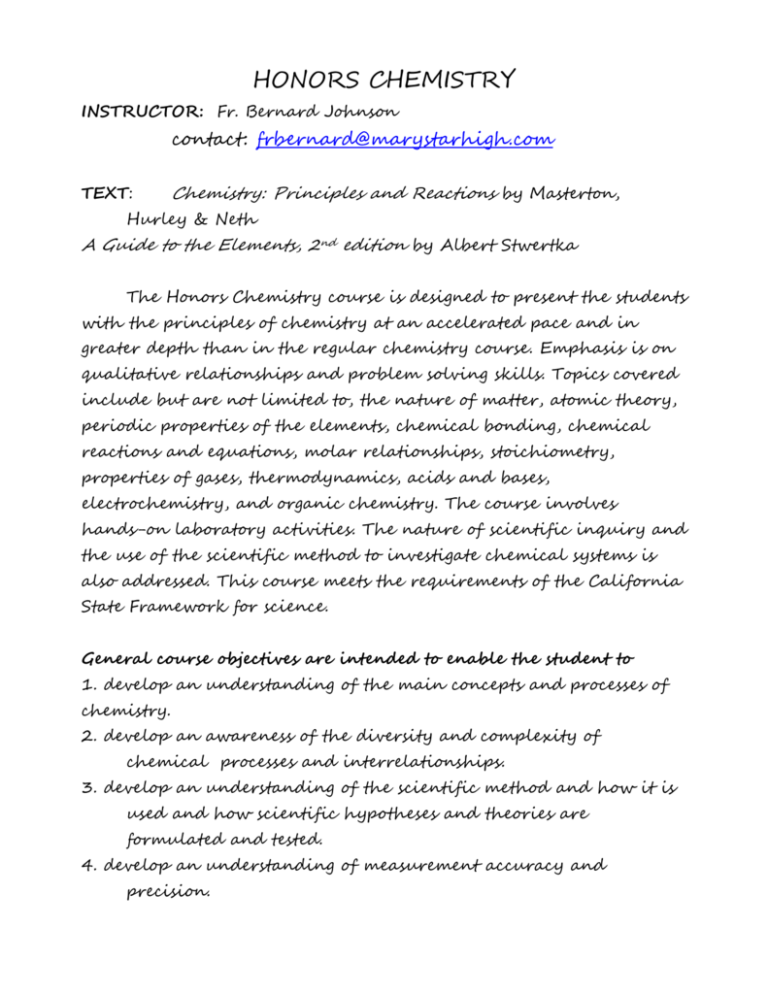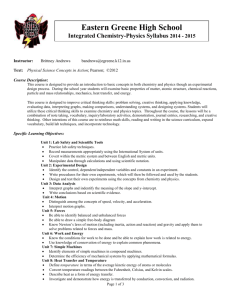General course objectives are intended to enable the student to
advertisement

HONORS CHEMISTRY INSTRUCTOR: Fr. Bernard Johnson contact: frbernard@marystarhigh.com TEXT: Chemistry: Principles and Reactions by Masterton, Hurley & Neth A Guide to the Elements, 2nd edition by Albert Stwertka The Honors Chemistry course is designed to present the students with the principles of chemistry at an accelerated pace and in greater depth than in the regular chemistry course. Emphasis is on qualitative relationships and problem solving skills. Topics covered include but are not limited to, the nature of matter, atomic theory, periodic properties of the elements, chemical bonding, chemical reactions and equations, molar relationships, stoichiometry, properties of gases, thermodynamics, acids and bases, electrochemistry, and organic chemistry. The course involves hands-on laboratory activities. The nature of scientific inquiry and the use of the scientific method to investigate chemical systems is also addressed. This course meets the requirements of the California State Framework for science. General course objectives are intended to enable the student to 1. develop an understanding of the main concepts and processes of chemistry. 2. develop an awareness of the diversity and complexity of chemical processes and interrelationships. 3. develop an understanding of the scientific method and how it is used and how scientific hypotheses and theories are formulated and tested. 4. develop an understanding of measurement accuracy and precision. 5. develop skills in solving chemistry related word problems especially including conversions. 6. develop an understanding of the major theories and paradigms used in chemistry and chemical research. 7. develop an awareness of the history of science and the men and women who have contributed to the advancement of the chemical and physical sciences. 8. develop an understanding of the different types of written reports used in chemistry, including but not limited to laboratory notes, laboratory reports, library research papers, field notes, field reports, and experimental research papers. 9. understand and connect to the study of chemistry the “expected schoolwide learning results” pertaining to Catholicism, Character, Curriculum, and Community. Specific course objectives will enable the student to 1. differentiate among types of matter and physical and chemical properties. 2. use the international system of measurement to measure physical and chemical properties; graph, perform calculations on, and determine quantitative relationships among these measurements; use conversion factors to change units of measured quantities; and determine the numbers of significant figures in calculated quantities. 3. use symbols for chemical cements; relate symbols to numbers of protons, neutrons, and electrons in atoms and ions; name ions and compounds; determine structural, molecular, and empirical formulas for covalent and ionic compounds and predict formulas for ionic compounds. 4. determine atomic mass, formula mass, and molar mass of elements and compounds, determine percent composition of compounds, balance chemical equations; use balanced equations to relate masses of reactants and products. 5. use solubility rules to predict results of chemical reactions and to determine concentrations of substances. 6. derive and use gas laws to determine pressure, volume, temperature, molar and kinetic relationships. 7. determine relationship among wavelength, frequency, energy, and quantum mechanics; use quantum mechanics to determine electron configurations of atoms and ions. 8. identify periodic trends in atomic radii, ionization energy, and electronegativity and use these trends to predict bond type and strength. 9. determine bond type; draw Lewis structures; and use the VSEPR model to predict molecular geometry of covalent compounds. 10. determine temperature relationships for closed systems; write thermochemical equations and use them to determine bond energies of reactants and products. 11. identify intermolecular forces in polar and nonpolar substances and determine their effects on physical properties. 12. differentiate between acids and bases and use indicators and titration to determine acidity. 13. name and differentiate among classes of organic compounds; draw structural formulas for isomers of organic compounds; and identify classes of organic compounds found in living systems. 15. determine the identity and composition of various chemical substances.











